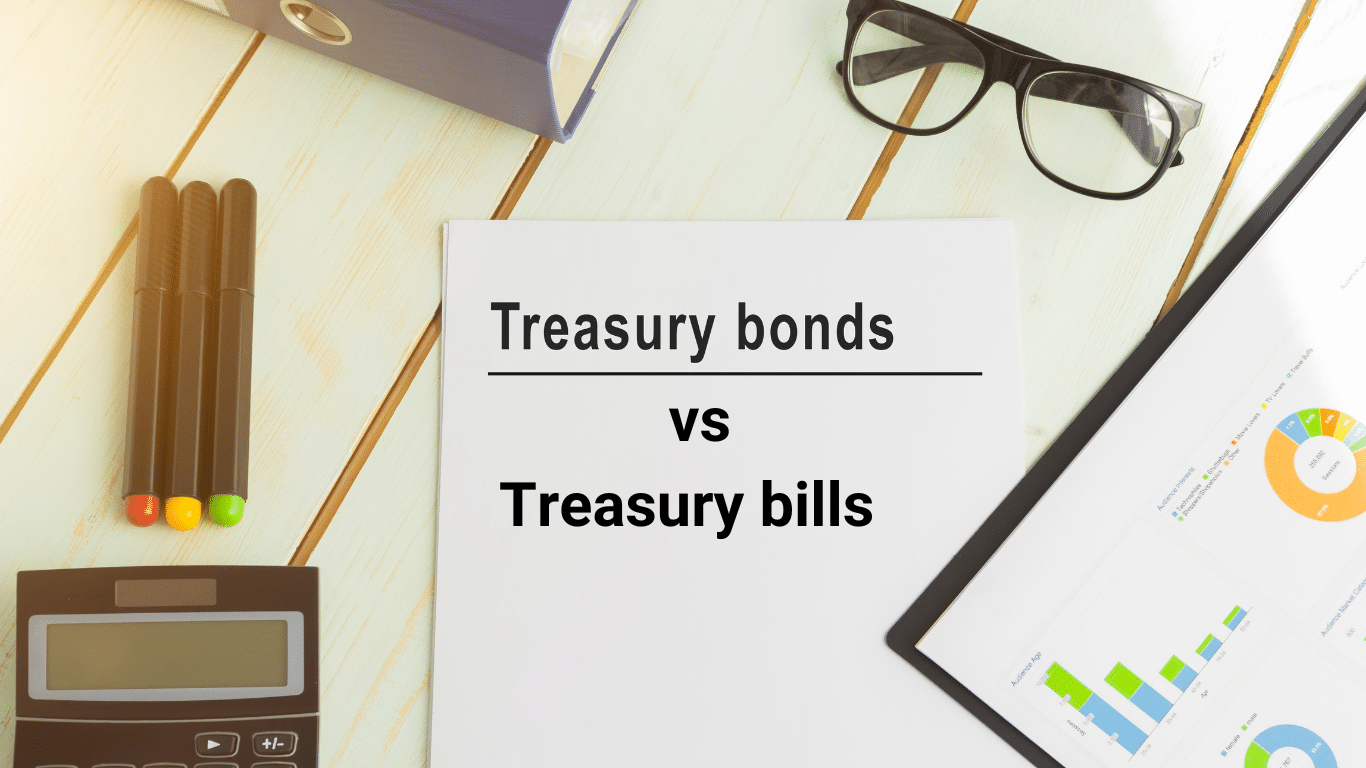When investing in fixed-income securities, treasury bond vs. bills are two popular options investors often consider. Bonds vs treasury bills are both issued by the government and considered low-risk investments. However, they have some essential differences that investors should be aware of before deciding. In this article, we will demystify the difference between treasury bonds and bills, explore their similarities and differences, discuss the benefits and drawbacks of investing in each, and provide some factors to consider when choosing between the two.
What is a treasury bond?

A treasury bond, also known as a government bond or a T-bond, is a debt security issued by the government to finance its operations and projects. Investors who purchase a treasury bond essentially lend money to the government for a fixed period. In return, the government pays the investor periodic interest payments, known as coupon payments, and returns the principal amount at the end of the bond’s maturity.
Treasury bonds typically have longer maturities, ranging from 10 to 30 years, making them suitable for long-term investors looking for a stable and predictable source of income. The interest rates on treasury bonds are fixed at the issuance, meaning that investors will receive a consistent return on their investment throughout the bond’s life.
What is a treasury bill?
A treasury bill, commonly known as a T-bill, is a government-issued short-term debt security with a maturity of less than one year.
Unlike treasury bonds, treasury bills do not pay periodic interest payments. Instead, they are issued at a discount to their face value and mature at their face value. The investor’s return on investment is the difference between the purchase price and the face value.
Investors often use Treasury bills vs government bonds to park their cash temporarily or manage their short-term liquidity needs. They are highly liquid and considered one of the safest investments available, as the full faith and credit of the government backs them.
Differences between treasury bond vs treasury bill:
While both treasury bonds vs treasury bills are issued by the government and considered low-risk investments, the two have several key differences.
The first significant difference is the maturity period. Treasury bonds have longer maturities, ranging from 10 to 30 years, while treasury bills have shorter maturities, usually less than one year. This difference in treasury bonds vs bills is in maturity, making treasury bonds more suitable for long-term investors looking for a stable and predictable source of income. In contrast, treasury bills are ideal for short-term investors looking for a safe place to park their cash temporarily.
Another key difference in government bond vs treasury bill is the way they generate returns. Treasury bonds pay periodic interest payments, known as coupon payments, while treasury bills are issued at a discount to their face value and mature at their face value. The return on investment for treasury bonds is based on the interest payments received over the bond’s life. In contrast, the return on investment for treasury bill vs bond is based on the difference between the purchase price and the face value.
Similarities between treasury bill vs treasury bond:
While treasury bills and bonds have differences, there are also some similarities.
One similarity is that the government issues treasury bonds and bills, which are considered low-risk investments. They are backed by the full faith and credit of the government, meaning that the government is obligated to pay the interest and principal to the investors. This makes them a safe haven for investors looking for a low-risk investment option.
Another similarity is that both t bills vs treasury bonds are highly liquid. They are easily bought and traded on the secondary market, letting investors to access their funds swiftly. This liquidity makes them popular among investors who value flexibility and accessibility.
Treasury Bills vs Corporate Bonds:
Treasury bills (T-bills) and corporate bonds differ significantly regarding issuer and risk. T-bills are issued by the United States government and are regarded as one of the most secure investments available. They have no default risk. Thus, they are a safe bet for capital preservation. On the other hand, corporate bonds are issued by businesses to raise finance. While they may offer higher yields than T-bills, they are subject to credit risk because the issuer’s financial health might affect the bond’s value. Investors must consider safety vs. possible profit when deciding between T-bills and corporate bonds.
Treasury Bills vs Municipal Bonds:
The difference between Treasury bills (T-bills) and municipal bonds falls in their issuer and tax implications. As we will discuss, T-bills are issued by the U.S. government and are exempt from state and local taxes, making them a reliable option for investors looking for tax efficiency. On the other hand, state and local governments issue municipal bonds and provide tax breaks at the federal, state, and, in some instances, local levels. While T-bills offer lower rates than municipal bonds, an investor’s tax bracket and preference for safety often influence the decision.
Treasury Bills vs Savings Bonds:
Treasury bills (T-bills) and savings bonds are both backed by the U.S. government but serve different objectives. T-bills are short-term instruments with maturities ranging from a few weeks to a year and are generally used for capital preservation and liquidity. Saving bonds in Series E.E. and Series I have maturities of up to 30 years, making them long-term savings instruments. They are intended for those who want to save for future purposes such as schooling or retirement. While T-bills give more liquidity, savings bonds offer a safe, long-term savings alternative with the possibility for inflation protection, depending on the series. The decision is influenced by an investor’s time horizon and financial objectives.
Benefits and drawbacks of investing in treasury bond vs bill:
Investing in government bonds vs treasury bills has its own benefits and drawbacks that investors should consider.

One of the main benefits of investing in treasury bonds is the stability and predictability of the income they provide. Treasury bonds generate periodic interest payments, which can be a dependable source of income for investors, particularly those seeking a consistent cash flow stream. Furthermore, treasury bonds are backed by the government’s complete faith and credit, making them a low-risk investment alternative.
However, there are also some drawbacks to investing in treasury bonds. One drawback is that the returns on treasury bonds are relatively low compared to other investment options. The interest rates on treasury bonds are fixed at the time of issuance, meaning that investors will not benefit from any increase in interest rates during the life of the bond. This can result in lower returns than other investments offering higher interest rates.
Benefits and drawbacks of investing in treasury bills:
Investing in treasury bills also has its own set of benefits and drawbacks.

One of the main benefits of investing in treasury bills is their short-term nature. Treasury bills have maturities of less than one year, so investors can quickly access their funds if needed. This makes them suitable for investors with short-term liquidity needs or who want to park their cash temporarily. Another benefit of investing in treasury bills is their high level of safety. Treasury bills are backed by the faith and credit of the government, making them a safe investment option.
However, there are also some drawbacks to investing in treasury bills. One drawback is that treasury bills do not provide a regular source of income, as they do not pay periodic interest payments. This can be a disadvantage for investors who are looking for a steady stream of cash flow. Additionally, the returns on treasury bills are relatively low compared to other investment options, as they are issued at a discount to their face value.
Factors to consider when choosing between treasury bond vs bill:
When choosing between treasury bonds and bills, there are several factors that investors should consider.
One factor to consider is the investment time horizon. Treasury bonds are more suitable for long-term investors looking for a stable source of income. In contrast, treasury bills are ideal for short-term investors looking for a safe place to park their cash temporarily.
Another factor to consider is the desired level of income. If an investor is looking for a regular source of income, treasury bonds may be a better option, as they pay periodic interest payments. On the other hand, if an investor does not require a regular source of income and is more focused on capital preservation, treasury bills may be a better option.
Additionally, investors should consider their risk tolerance. While both treasury bills vs bonds are considered low-risk investments, treasury bonds may offer more stability and predictability of income, while treasury bills may offer more liquidity and flexibility.
How to invest in treasury bonds and bills?
Investing in treasury bonds and bills is relatively straightforward. Investors can purchase treasury bonds and bills directly from the government through the TreasuryDirect website or a brokerage firm.
Investors can visit the TreasuryDirect website to invest in treasury bonds and open an account. Once the account is active, investors can choose from various treasury bonds with different maturities and purchase them directly from the government. Investors can also purchase treasury bonds through a brokerage firm, which may offer additional services and support.
To invest in treasury bills, investors can follow a similar process. They can visit the TreasuryDirect website or contact a brokerage firm to purchase treasury bills directly from the government. Treasury bills are typically sold in denominations of $1,000 or more.
Conclusion – Treasury Bill vs Bonds:
In conclusion, understanding the difference between treasury bills vs treasury bonds is crucial for investing in fixed-income securities. While both options offer low-risk investment opportunities, they have key differences in maturity, returns, and suitability for different investment goals.
Investing in treasury bonds can provide stability and predictability of income, making them suitable for long-term investors looking for a steady cash flow. On the other hand, investing in treasury bills can offer short-term liquidity and capital preservation, making them suitable for investors with short-term needs or who want to park their cash temporarily.
Ultimately, the decision between treasury bonds and bills depends on factors such as investment time horizon, desired level of income, and risk tolerance. Investors can make decisions that coincide with their investing goals and risk profile by carefully analysing these aspects and understanding the pros and cons of each option.
So, whether you are a long-term investor seeking stability or a short-term investor needing liquidity, treasury bonds and bills offer distinct advantages. It’s up to you to decide which suits your investment needs best.

